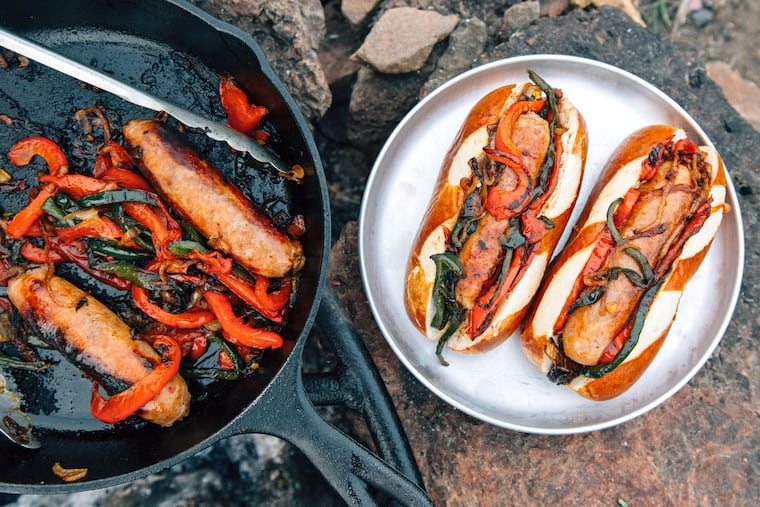Camping food: What to pack, what to cook, whether you’re basic or Bear Grylls
Plus: Easy, medium, and hard options for a campfire meal.

Crisp October weather sets the stage for weekends in the woods — the best part of which is cooking outdoors.
“Theoretically, you can cook anything you would at home on a fire,” says Yan Hryciw, REI regional coordinator for the Philadelphia region. “It’s a function of how much work you’re willing to put into it.”
We talked to avid campers and experts to gather tips for better camp cooking, whether you’re basic or Bear Grylls.
The right equipment
To stay organized, create an equipment checklist. Start with the basics, then review your meal plan to determine what else you’ll need.
“Start by thinking about everything you use in the kitchen, and then pare down to the essentials,” says Katie Briggs, a West-Philly-based pop-up chef and founder of Eclectik Domestic. “Many Swiss army knives have wine opener attachments, and there all-in-one fork-spoon-knife contraptions you can buy, too.”
Prep as much as you can at home.
“When all you have to do at the site is toss dressing on a premade salad and heat up a precooked chili, that’s less effort and cleanup,” advises avid camper and home cook Barry Enders, general manager at Philadelphia Distilling.
Be sure to call the campsite in advance and ask questions: Does the fire pit have grates? Is firewood sold on-site? Is the water potable?
Seasoned campers develop preferences for certain equipment. When it comes to coolers, Hryciw highly endorses the top-notch insulation of the YETI Tundra 65, which is a splurge. And if you prefer a less rustic heat source than a fire, invest in a camp stove.
“There are two main types of stoves — canister and liquid fuel," Hryciw says. “Canister stoves are smaller and more packable, but harder to control and only fit small pots. If car camping, opt for liquid fuel, like a Coleman or a Primus.”
Cast-iron skillets and Dutch ovens are another smart cookware add. They can be placed directly in the fire or on a grate to make everything from eggs to apple crisp (recipe below). When picking out a cook pot, just make sure the one you bring along doesn’t have a rubber handle that could melt over high heat.
For plates, Briggs says enamel dinnerware is super popular because it’s sturdy but light, and cheap.
Other cooking gear is less expensive, lighter-weight, and equally helpful. Extendable metal skewers make roasting hot dogs and marshmallows exponentially easier. Hard plastic egg holders can prevent eggs from cracking in a packed cooler. And a bear bag safeguards food from animals; REI specialist Hryciw uses the Loksak Opsak Odor-Proof Barrier Bags.
The right ingredients
The following list will take you far for seasoning and sustenance. Consider what ingredients you use daily at home and add them to the list accordingly.
A meal plan is a must: Map out breakfast, lunch, and dinner for each day. This helps ensure you won’t run out of food and reduces mealtime stress, especially after long hikes. It also helps you know what to pack.
After you assemble the basics, consider small but powerful ingredients upgrades. Spices — even as basic as paprika, dried onion, and Old Bay — will jazz up foil-pouch-cooked vegetables like potatoes and corn. Cinnamon instantly boosts oatmeal and peanut butter-and-banana sandwiches.
Dried fruit and nuts add texture to oatmeal, yogurt, and salads — and they double as energy-dense snacks. Canned fish and cured meats pack both protein and flavor and can be mixed into rice dishes and salads.
Starches aren’t limited to bread: Boil-in-a-bag rice and tortillas are campfire-friendly.
And keep in mind that luxury ingredients like high-quality chocolate or fancy mustard become even more satisfying when away from everyday comforts.
Simple meals and ways to elevate them
If you have access to a large cooler and a place to resupply ice, the camp cooking options are endless. Breakfast staples like oatmeal can be bolstered with nut butter, fruit, cinnamon, honey, and salt. Take it to the next level with honey-drizzled grilled fruit, which makes an excellent topping for yogurt and granola, too. Or go big with skillet eggs and toast. Upgrade that by adding sauteed peppers and onions, maybe beans, for breakfast tacos.
For lunch, vary a classic PB&J by swapping the jelly for bananas or sliced apples and honey. Or try Enders’ version: banana drizzled with honey and Sriracha, wrapped in a whole-wheat tortilla. (He always packs a refillable mini-Sriracha bottle.)
“When you’re out in the woods, you have to get used to the same flavors over and over, so it’s nice to have a little something extra,” he says.
Dress up another lunch go-to, hummus and pita, with sliced eggs (hard-boiled at home).
For dinner, hot dogs or bratwurst are a must. Both are even better when sautéed with julienned onions and peppers. Top with canned chili for an easy upgrade, and pair with premade sides, like potato salad, broccoli salad, or pasta salad.
Heating up soups and stews made at home, and pairing them with a hunk of high-quality bread, makes a simple but substantial meal. Or roast foil-wrapped sweet or baked potatoes in the embers of the fire, and top with canned black beans laced with spices (cumin, chili powder, paprika), hot sauce, and sautéed peppers and onions. Swap the potatoes for rice to make a burrito bowl.
For salads, mix the vegetables beforehand and hold the premade dressing till you’re ready to eat. Briggs suggests a vinaigrette of two parts olive oil to one part apple cider vinegar, shaken with a dollop of Dijon mustard and pinch of dried onion, salt, and pepper. Store in a mason jar to reshake.
“It doesn’t need to be refrigerated, and works well to season any sort of roasted veggie, too” she says.